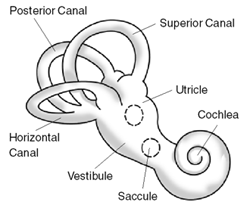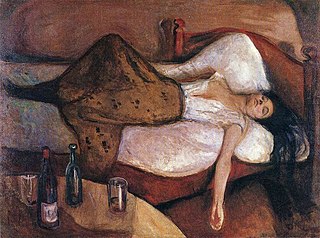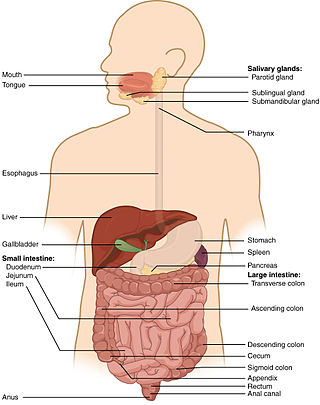Related Research Articles
Ataxia is a neurological sign consisting of lack of voluntary coordination of muscle movements that can include gait abnormality, speech changes, and abnormalities in eye movements, that indicates dysfunction of parts of the nervous system that coordinate movement, such as the cerebellum. These nervous system dysfunctions occur in several different patterns, with different results and different possible causes. Ataxia can be limited to one side of the body, which is referred to as hemiataxia. Friedreich's ataxia has gait abnormality as the most commonly presented symptom. Dystaxia is a mild degree of ataxia.

Alcohol intoxication, also known in overdose as alcohol poisoning, commonly described as drunkenness or inebriation, is the negative behavior and physical effects caused by a recent consumption of alcohol. In addition to the toxicity of ethanol, the main psychoactive component of alcoholic beverages, other physiological symptoms may arise from the activity of acetaldehyde, a metabolite of alcohol. These effects may not arise until hours after ingestion and may contribute to the condition colloquially known as a hangover.

Ménière's disease (MD) is a disease of the inner ear that is characterized by potentially severe and incapacitating episodes of vertigo, tinnitus, hearing loss, and a feeling of fullness in the ear. Typically, only one ear is affected initially, but over time, both ears may become involved. Episodes generally last from 20 minutes to a few hours. The time between episodes varies. The hearing loss and ringing in the ears can become constant over time.

Motion sickness occurs due to a difference between actual and expected motion. Symptoms commonly include nausea, vomiting, cold sweat, headache, dizziness, tiredness, loss of appetite, and increased salivation. Complications may rarely include dehydration, electrolyte problems, or a lower esophageal tear.

A cannabis edible, also known as a cannabis-infused food or simply an edible, is a food item that contains decarboxylated cannabinoids from cannabis extract as an active ingredient. Although edible may refer to either a food or a drink, a cannabis-infused drink may be referred to more specifically as a liquid edible or drinkable. Edibles are a way to consume cannabis. Unlike smoking, in which cannabinoids are inhaled into the lungs and pass rapidly into the bloodstream, peaking in about ten minutes and wearing off in a couple of hours, cannabis edibles may take hours to digest, and their effects may peak two to three hours after consumption and persist for around six hours. The food or drink used may affect both the timing and potency of the dose ingested.
A balance disorder is a disturbance that causes an individual to feel unsteady, for example when standing or walking. It may be accompanied by feelings of giddiness, or wooziness, or having a sensation of movement, spinning, or floating. Balance is the result of several body systems working together: the visual system (eyes), vestibular system (ears) and proprioception. Degeneration or loss of function in any of these systems can lead to balance deficits.

The vestibular system, in vertebrates, is a sensory system that creates the sense of balance and spatial orientation for the purpose of coordinating movement with balance. Together with the cochlea, a part of the auditory system, it constitutes the labyrinth of the inner ear in most mammals.

Dizziness is an imprecise term that can refer to a sense of disorientation in space, vertigo, or lightheadedness. It can also refer to disequilibrium or a non-specific feeling, such as giddiness or foolishness.

Labyrinthitis is inflammation of the labyrinth, a maze of fluid-filled channels in the inner ear. Vestibular neuritis is inflammation of the vestibular nerve. Both conditions involve inflammation of the inner ear. Labyrinths that house the vestibular system sense changes in the head's position or the head's motion. Inflammation of these inner ear parts results in a sensation of the world spinning and also possible hearing loss or ringing in the ears. It can occur as a single attack, a series of attacks, or a persistent condition that diminishes over three to six weeks. It may be associated with nausea, vomiting, and eye nystagmus.
Lightheadedness is a common and typically unpleasant sensation of dizziness or a feeling that one may faint. The sensation of lightheadedness can be short-lived, prolonged, or, rarely, recurring. In addition to dizziness, the individual may feel as though their head is weightless. The individual may also feel as though the room is "spinning" or moving (vertigo). Most causes of lightheadedness are not serious and either cure themselves quickly, or are easily treated.

Vertigo is a condition in which a person has the sensation of movement or of surrounding objects moving when they are not. Often it feels like a spinning or swaying movement. This may be associated with nausea, vomiting, sweating, or difficulties walking. It is typically worse when the head is moved. Vertigo is the most common type of dizziness.

The vestibular nerve is one of the two branches of the vestibulocochlear nerve. In humans the vestibular nerve transmits sensory information transmitted by vestibular hair cells located in the two otolith organs and the three semicircular canals via the vestibular ganglion of Scarpa. Information from the otolith organs reflects gravity and linear accelerations of the head. Information from the semicircular canals reflects rotational movement of the head. Both are necessary for the sensation of body position and gaze stability in relation to a moving environment.

A hangover is the experience of various unpleasant physiological and psychological effects usually following the consumption of alcohol, such as wine, beer, and liquor. Hangovers can last for several hours or for more than 24 hours. Typical symptoms of a hangover may include headache, drowsiness, concentration problems, dry mouth, dizziness, fatigue, gastrointestinal distress, absence of hunger, light sensitivity, depression, sweating, nausea, hyper-excitability, irritability, and anxiety.
Alcohol and sex deals with the effects of the consumption of alcohol on sexual behavior. The effects of alcohol are balanced between its suppressive effects on sexual physiology, which will decrease sexual activity, and its suppression of psychological inhibitions, which may increase the desire for sex.
Kindling due to substance withdrawal refers to the neurological condition which results from repeated withdrawal episodes from sedative–hypnotic drugs such as alcohol and benzodiazepines.

Auto-brewery syndrome(ABS) (also known as gut fermentation syndrome, endogenous ethanol fermentation or drunkenness disease) is a condition characterized by the fermentation of ingested carbohydrates in the gastrointestinal tract of the body caused by bacteria or fungi. ABS is a rare medical condition in which intoxicating quantities of ethanol are produced through endogenous fermentation within the digestive system. The organisms responsible for ABS include various yeasts and bacteria, including Saccharomyces cerevisiae, S. boulardii, Candida albicans, C. tropicalis, C. krusei, C. glabrata, C. kefyr, C. parapsilosis, Klebsiella pneumoniae, and Enterococcus faecium. These organisms use lactic acid fermentation or mixed acid fermentation pathways to produce an ethanol end product. The ethanol generated from these pathways is absorbed in the small intestine, causing an increase in blood alcohol concentrations that produce the effects of intoxication without the consumption of alcohol.

Methanol toxicity is poisoning from methanol, characteristically via ingestion. Symptoms may include a decreased level of consciousness, poor or no coordination, vomiting, abdominal pain, and a specific smell on the breath. Decreased vision may start as early as twelve hours after exposure. Long-term outcomes may include blindness and kidney failure. Blindness may occur after drinking as little as 10 mL; death may occur after drinking quantities over 15 mL.
The term chronic subjective dizziness (CSD) is used to describe a commonly encountered type of dizziness that is not easily categorized into one of several other types, and for which the physical examination is typically normal. Patients with CSD frequently initially suffer a sudden injury of some sort to their vestibular system, the neurologic network that preserves sense of balance. Even after this initial injury has healed, people with CSD usually describe a vague sense of unsteadiness worsened by triggers in their environment such as high places, standing on moving objects, or standing in motion-rich environments like busy streets or crowds. There is a clear indication that anxiety and other mental illnesses play a role in the dizziness symptoms that occur with CSD. However, the condition is categorized as chronic functional vestibular disorder, not as a structural or psychiatric condition.

Alcohol, sometimes referred to by the chemical name ethanol, is a depressant drug that is the active ingredient in drinks such as beer, wine, and distilled spirits. It is one of the oldest and most commonly consumed recreational drugs, causing the characteristic effects of alcohol intoxication ("drunkenness"). Among other effects, alcohol produces happiness and euphoria, decreased anxiety, increased sociability, sedation, impairment of cognitive, memory, motor, and sensory function, and generalized depression of central nervous system (CNS) function. Ethanol is only one of several types of alcohol, but it is the only type of alcohol that is found in alcoholic beverages or commonly used for recreational purposes; other alcohols such as methanol and isopropyl alcohol are significantly more toxic. A mild, brief exposure to isopropanol, being only moderately more toxic than ethanol, is unlikely to cause any serious harm. Methanol, being profoundly more toxic than ethanol, is lethal in quantities as small as 10–15 milliliters.

Vestibular rehabilitation (VR), also known as vestibular rehabilitation therapy (VRT), is a specialized form of physical therapy used to treat vestibular disorders or symptoms, characterized by dizziness, vertigo, and trouble with balance, posture, and vision. These primary symptoms can result in secondary symptoms such as nausea, fatigue, and lack of concentration. All symptoms of vestibular dysfunction can significantly decrease quality of life, introducing mental-emotional issues such as anxiety and depression, and greatly impair an individual, causing them to become more sedentary. Decreased mobility results in weaker muscles, less flexible joints, and worsened stamina, as well as decreased social and occupational activity. Vestibular rehabilitation therapy can be used in conjunction with cognitive behavioral therapy in order to reduce anxiety and depression resulting from an individual's change in lifestyle.
References
- ↑ Leiva DM. "Women's Voices on College Drinking: The First-Year College Experience". College of Education. The Florida State University. Archived from the original on 2012-05-22.
- 1 2 3 4 5 "Marijuana / Cannabis". Dartmouth College . 17 July 2018.
- ↑ Gibson P. "Battery Review". patrickgibson.com.
- 1 2 Hautman P (20 February 2002). Rag Man. ISBN 9780743217699.
- 1 2 "Alcohol and Drug Interactions" (PDF). Prevention and Wellness Services. Western Washington University.
- 1 2 Lederman LC, Stewart LP, Laitman L, Goodhart F, Powell R. "A Case Against "Binge" as the Term of Choice: How to Get College Students to Personalize Messages about Dangerous Drinking" (PDF). The Higher Education Center for Alcohol and Other Drug Prevention.
- ↑ Peck T. "Today's spotlight sermon on Addiction". FlockFinder.com.
- 1 2 Porter M. "Dr Mark Porter on giddy turns". Discovery Channel Ask the Expert.
- ↑ Wolfsberg J (October 2007). "Ask the Drug Guy: Is the phrase "Beer before liquor, never sicker - liquor before beer, in the clear" accurate, and if so, why?". Archived from the original on February 20, 2012. Retrieved February 10, 2013.
- 1 2 "Food pairings: Working for or against you?"". CNN .
- ↑ "Alcohol". treatment-now.com.
- ↑ Tianwu H, Watanabe Y, Asai M, Shimizu K, Takada S, Mizukoshi K (1995). "Effects of alcohol ingestion on vestibular function in postural control". Acta Oto-Laryngologica. Supplementum. 519: 127–131. doi:10.3109/00016489509121886. PMID 7610847.
- ↑ Post RB, Lott LA, Beede JI, Maddock RJ (May–Jun 1994). "The effect of alcohol on the vestibulo-ocular reflex and apparent concomitant motion". Journal of Vestibular Research. 4 (3): 181–187. PMID 7921336.
- ↑ Fetter M, Haslwanter T, Bork M, Dichgans J (February 1999). "New insights into positional alcohol nystagmus using three-dimensional eye-movement analysis". Annals of Neurology. 45 (2): 216–223. doi:10.1002/1531-8249(199902)45:2<216::aid-ana12>3.0.co;2-f. PMID 9989624. S2CID 25697152.
- ↑ Patrick ME, Lee CM (2018-07-07). "Cross-faded: Young Adults' Language of Being Simultaneously Drunk and High". Cannabis. 1 (2): 60–65. doi:10.26828/cannabis.2018.02.006. PMC 6329594 . PMID 30643908.
- ↑ Rich C (November 2004). "Getting High". Washingtonian .
- ↑ Horak FB (2010). "Postural compensation for vestibular loss and implications for rehabilitation". Restorative Neurology and Neuroscience. 28 (1): 57–68. doi:10.3233/RNN-2010-0515. PMC 2965039 . PMID 20086283.
- ↑ Horak FB (2010). "Postural compensation for vestibular loss and implications for rehabilitation". Restorative Neurology and Neuroscience. 28 (1): 57–68. doi:10.3233/RNN-2010-0515. PMC 2965039 . PMID 20086283.
- 1 2 "Natural Hang Over Cure - Kind Of!". Craig Hitchens Therapies.
- ↑ Keefe J (2002). Being Irish. ISBN 9780740719974.
- ↑ Gilovich P, Vogel T (2001). The Stranger Guide to Seattle. ISBN 9781570612565.
- ↑ Burke JL (17 July 2007). The Tin Roof Blowdown. ISBN 9781416559887.